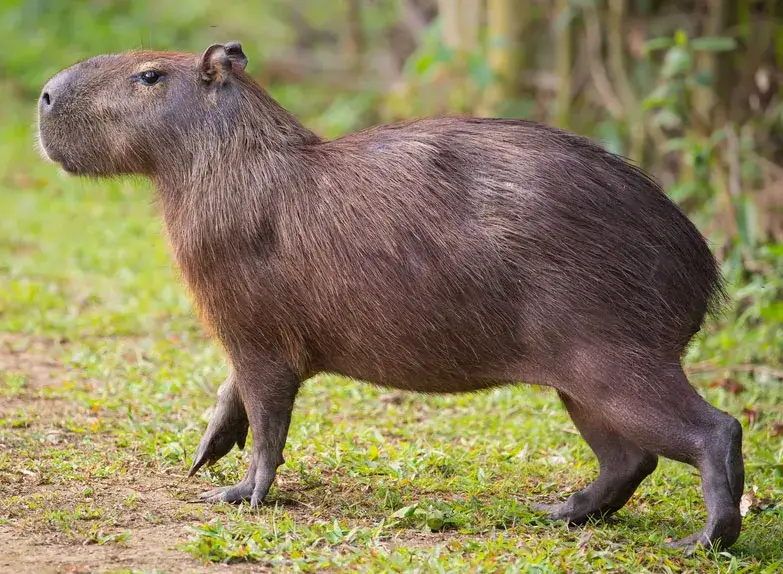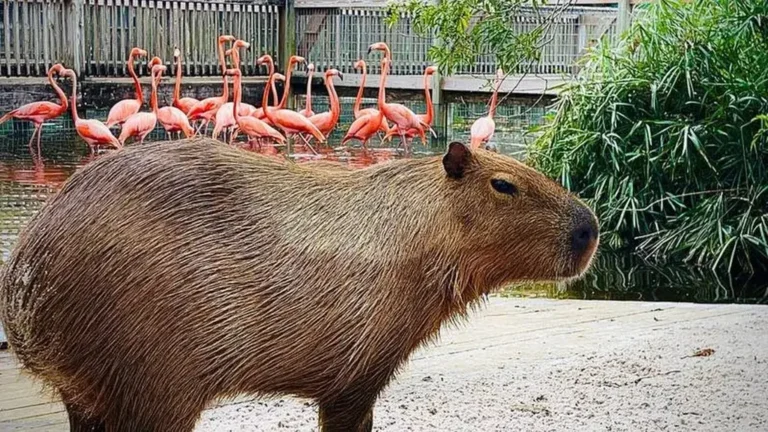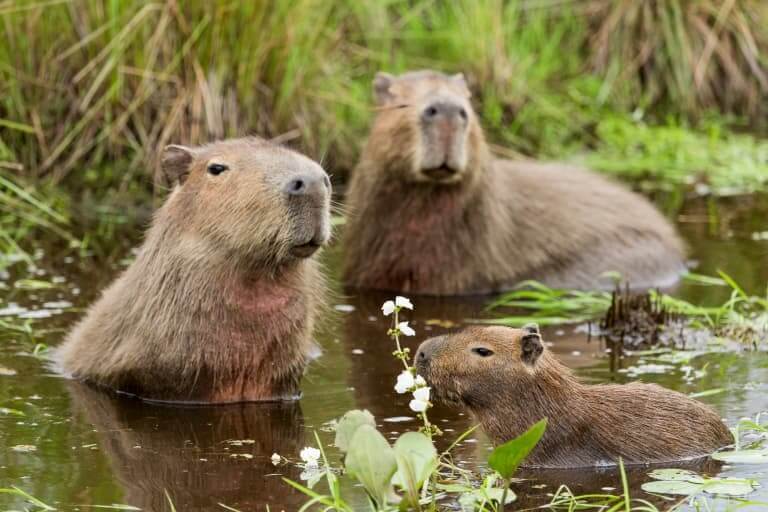Capybara Size: How Much Do Capybaras Weigh?
Curious about capybara size? These gentle giants are the world’s largest rodents, renowned for their friendly nature and unique weight range that highlights their distinctive build.
Contents
How Much Do Capybaras Weigh?

Capybaras boast an impressive size, with adults ranging from 60 to 174 pounds on average. Males typically outweigh females, with the latter falling slightly lighter. Various factors influence their weight, including age, region, and food availability. While exceptional cases may exceed the average, focusing on the typical representation of their weight is essential.
What is the weight of a capybara?
Capybaras typically weigh between 77 to 150 pounds, with variations due to age, environment, and diet. Known as the largest rodents, their size and social habits make them unique animals in South America.
How Much Do Baby Capybaras Weigh?
Newborn capybaras enter the world with surprising vigor, weighing between two to four pounds. Despite their petite size at birth, they experience rapid growth, reaching up to 88 pounds by 18 weeks. Their journey to full size concludes around 18 months, marking the onset of sexual maturity.
How Much Do Lesser Capybaras Weigh?
The lesser capybara is a smaller counterpart to its common relative. Weighing between 60 to 80 pounds, these diminutive creatures contrast the larger capybaras. Their restricted diet and habitat contribute to their reduced size, highlighting the role of the environment in shaping species characteristics.
Related: The Sociable Side Of Capybaras
Do Capybaras Make Good Pets?
The allure of capybaras as exotic pets is undeniable, yet their suitability requires careful consideration. Legal and ethical concerns, coupled with their substantial space and resource needs, underscore the challenges of pet ownership. While they possess a gentle disposition, responsible ownership, and thorough research are imperative to ensure their welfare.
How Weight Affects Care
Understanding the correlation between weight and care is paramount in catering to capybaras’ needs. Tailoring diets to their weight and activity levels, providing ample habitat space for movement, and addressing weight-related health concerns are pivotal aspects of responsible care. By prioritizing these elements, owners can uphold the well-being of their capybara companions.
Related: Are Capybaras Friendly Or Dangerous?
Conclusion
Capybaras epitomizes the harmony between size, weight, and demeanor, captivating enthusiasts worldwide. Through a nuanced understanding of their characteristics and care requirements, we can forge fulfilling relationships with these gentle giants. Embracing their unique traits while honoring their specific needs ensures a harmonious coexistence between humans and capybara.
Frequently Asked Questions (FAQs) About Capybaras
How much does a capybara weigh in kg?
Capybaras typically weigh between 35 to 70 kg. Males are usually lighter, while females may reach the higher end of this range due to their larger size.
Are capybaras heavy?
Yes, capybaras are relatively heavy for rodents, reaching up to 70 kg. Their solid, barrel-shaped bodies support their semi-aquatic lifestyle, making them the heaviest rodents on Earth.
Is capybara a pig?
No, capybaras are not pigs. They belong to the rodent family, specifically the Caviidae family, and are more closely related to guinea pigs than to pigs.
Is a capybara a big rat?
While capybaras belong to the rodent order like rats, they aren’t classified as rats. Capybaras are part of the Caviidae family and are significantly larger, more like giant guinea pigs in size and social behavior.
Can capybaras bite?
Yes, capybaras can bite if they feel threatened or stressed. However, they are generally docile animals and rarely bite unless provoked. Their teeth are designed for grazing and can cause significant injury if used defensively.
Can a capybara be a pet?
In some places, capybaras can be kept as pets, though they require special care, ample space, and access to water. Potential pet owners should check local laws, as capybara ownership is restricted in many areas.
Is capybara haram?
The classification of capybara as halal or haram varies across Islamic communities. Some scholars consider it haram due to its rodent classification, while others find it permissible. Consultation with a local religious authority is advised.
Is capybara friendly?
Yes, capybaras are known for their friendly, social nature. They live in groups and are often comfortable around humans and other animals, which makes them popular animals to observe in zoos and wildlife centers.
What religion eats capybara?
During Lent, Catholics in some South American regions, particularly Venezuela, consume capybara. The Catholic Church has classified it as “fish” for fasting purposes, allowing consumption during certain fasting periods.
What is a capybara’s lifespan?
Capybaras live for about 8 to 10 years in captivity. In the wild, their lifespan is shorter, often around 4 years, due to predation and environmental factors.
Can capybaras bark?
Yes, capybaras can bark, especially when they sense danger or need to communicate within their group. Their bark is used to alert others of potential threats and to maintain social bonds.
What eats capybaras?
Capybaras are preyed upon by jaguars, caimans, and anacondas in the wild. Large birds of prey, such as eagles, may also target young capybaras, as do smaller carnivores like ocelots.
1. Are capybaras dangerous animals?
A: Capybaras are generally not considered dangerous animals. They have a gentle demeanor and are known to tolerate humans and other animals. However, like wild animals, they can become defensive if threatened or cornered.
2. Can capybaras be kept as pets?
A: Yes, capybaras can be kept as pets, but it’s essential to understand the significant commitment involved. They require ample space, specialized care, and social interaction with other capybaras. Additionally, laws and regulations regarding capybara ownership vary by location, so prospective owners should research local guidelines before considering one as a pet.
3. Do capybaras get along with other pets?
A: Capybaras are generally social animals and can get along well with other pets if introduced properly. They often form strong bonds with other animals, including dogs, cats, and birds. However, supervision is crucial during introductions and monitoring interactions to ensure the safety and well-being of all pets involved is essential.
4. What do capybaras eat?
A: Capybaras are herbivores, feeding on grasses, aquatic plants, and fruits. They should have a diet rich in high-quality hay, fresh vegetables, and commercial rodent pellets in captivity. It’s essential to mimic their natural diet as closely as possible to maintain their health and well-being.
5. How big do capybaras get?
A: Capybaras are the most giant rodents in the world, with adults typically weighing between 60 and 174 pounds. They can grow to be around two feet tall at the shoulder and up to four feet long. Males are generally larger than females, but individual size can vary based on factors such as genetics and nutrition.
6. Are capybaras legal to own as pets?
A: The legality of owning a capybara as a pet varies depending on location. In some areas, they may be considered exotic pets and require special permits or licenses. It’s essential to research local laws and regulations regarding capybara ownership before acquiring one as a pet to ensure compliance with legal requirements.
7. Do capybaras require special care?
A: Yes, capybaras require specialized care to thrive in captivity. They need access to a large outdoor enclosure with plenty of space for swimming and grazing. Additionally, they require a diet rich in fiber and regular veterinary care to maintain their health. Owners should also provide opportunities for social interaction and mental stimulation to ensure their well-being.
8. Are capybaras aggressive towards humans?
A: Capybaras are typically docile animals and rarely show aggression towards humans. However, they may become defensive if they feel threatened or provoked. Respecting their boundaries and approaching them calmly and gently to avoid potential conflicts is essential.
9. Do capybaras require vaccinations?
A: While capybaras may not require vaccinations like dogs or cats, they should still receive regular veterinary check-ups to monitor their health. A veterinarian may recommend vaccinations based on factors such as the capybara’s lifestyle, risk of exposure to infectious diseases, and local health guidelines.
10. Are capybaras endangered?
A: Capybaras are not currently considered endangered, and their populations are relatively stable in their native habitats. However, habitat loss, hunting, and other human activities can threaten their survival in certain regions. Conservation efforts are essential to ensure the long-term viability of capybara populations and their natural habitats.
- Golden Retriever Pros and Cons: What Every Pet Parent Should Know - 15 September 2025
- Cane Corso Dog Breed: Health, Care, and Lifespan - 14 September 2025
- Catahoula Leopard Dogs: Description, Temperament, Lifespan, & Facts - 21 July 2025






